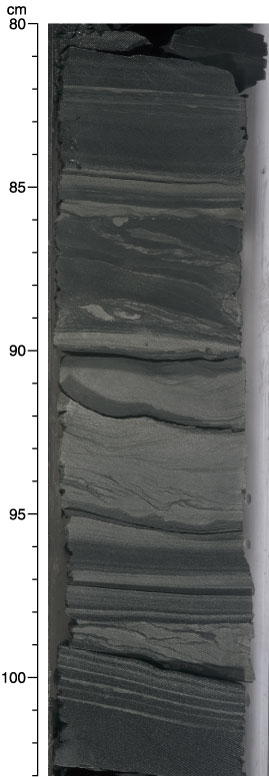
Figure F82. Close-up of a complex interval of turbidity-current deposition. Inclined laminae (99-102 cm) might record repeated deposition from low-density flows passing over a topographically irregular seafloor. The lenticular distorted interval above this (98-99 cm) may record the infill of local seabed relief. The interval from 86 to 98 cm is interpreted as a single sand  silt
silt  mud turbidite, with a basal planar-laminated division (96-98 cm), followed by a climbing ripple division (90-96 cm), and then a convoluted division characterized by soft-sediment deformation (86-90 cm). A subsequent turbidity current deposited sand and silt above a scoured base at 86 cm. This interval as a whole illustrates a complex interplay between turbidity-current deposition and an inferred irregular seafloor topography (Subunit 5B: interval 210-1276A-72R-1, 80-103 cm).
mud turbidite, with a basal planar-laminated division (96-98 cm), followed by a climbing ripple division (90-96 cm), and then a convoluted division characterized by soft-sediment deformation (86-90 cm). A subsequent turbidity current deposited sand and silt above a scoured base at 86 cm. This interval as a whole illustrates a complex interplay between turbidity-current deposition and an inferred irregular seafloor topography (Subunit 5B: interval 210-1276A-72R-1, 80-103 cm).


 silt
silt  mud turbidite, with a basal planar-laminated division (96-98 cm), followed by a climbing ripple division (90-96 cm), and then a convoluted division characterized by soft-sediment deformation (86-90 cm). A subsequent turbidity current deposited sand and silt above a scoured base at 86 cm. This interval as a whole illustrates a complex interplay between turbidity-current deposition and an inferred irregular seafloor topography (Subunit 5B: interval 210-1276A-72R-1, 80-103 cm).
mud turbidite, with a basal planar-laminated division (96-98 cm), followed by a climbing ripple division (90-96 cm), and then a convoluted division characterized by soft-sediment deformation (86-90 cm). A subsequent turbidity current deposited sand and silt above a scoured base at 86 cm. This interval as a whole illustrates a complex interplay between turbidity-current deposition and an inferred irregular seafloor topography (Subunit 5B: interval 210-1276A-72R-1, 80-103 cm).

![]()